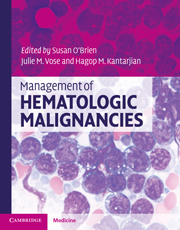Book contents
- Frontmatter
- Contents
- List of contributors
- 1 Molecular pathology of leukemia
- 2 Management of acute myeloid leukemia
- 3 Treatment of acute lymphoblastic leukemia (ALL) in adults
- 4 Chronic myeloid leukemia
- 5 Chronic lymphocytic leukemia/small lymphocytic lymphoma
- 6 Myelodysplastic syndromes (MDS)
- 7 Hairy cell leukemia
- 8 Acute promyelocytic leukemia: pathophysiology and clinical results update
- 9 Myeloproliferative neoplasms
- 10 Monoclonal gammopathy of undetermined significance, smoldering multiple myeloma, and multiple myeloma
- 11 Amyloidosis and other rare plasma cell dyscrasias
- 12 Waldenstrom's macroglobulinemia/lymphoplasmacytic lymphoma
- 13 WHO classification of lymphomas
- 14 Molecular pathology of lymphoma
- 15 International staging and response criteria for lymphomas
- 16 Treatment approach to diffuse large B-cell lymphomas
- 17 Mantle cell lymphoma
- 18 Follicular lymphomas
- 19 Hodgkin lymphoma: epidemiology, diagnosis, and treatment
- 20 Treatment approaches to MALT/marginal zone lymphoma
- 21 Peripheral T-cell lymphomas
- 22 Mycosis fungoides and Sézary syndrome
- 23 Central nervous system lymphoma
- 24 HIV-related lymphomas
- 25 Lymphoblastic lymphoma
- 26 Burkitt lymphoma
- Index
- References
2 - Management of acute myeloid leukemia
Published online by Cambridge University Press: 10 January 2011
- Frontmatter
- Contents
- List of contributors
- 1 Molecular pathology of leukemia
- 2 Management of acute myeloid leukemia
- 3 Treatment of acute lymphoblastic leukemia (ALL) in adults
- 4 Chronic myeloid leukemia
- 5 Chronic lymphocytic leukemia/small lymphocytic lymphoma
- 6 Myelodysplastic syndromes (MDS)
- 7 Hairy cell leukemia
- 8 Acute promyelocytic leukemia: pathophysiology and clinical results update
- 9 Myeloproliferative neoplasms
- 10 Monoclonal gammopathy of undetermined significance, smoldering multiple myeloma, and multiple myeloma
- 11 Amyloidosis and other rare plasma cell dyscrasias
- 12 Waldenstrom's macroglobulinemia/lymphoplasmacytic lymphoma
- 13 WHO classification of lymphomas
- 14 Molecular pathology of lymphoma
- 15 International staging and response criteria for lymphomas
- 16 Treatment approach to diffuse large B-cell lymphomas
- 17 Mantle cell lymphoma
- 18 Follicular lymphomas
- 19 Hodgkin lymphoma: epidemiology, diagnosis, and treatment
- 20 Treatment approaches to MALT/marginal zone lymphoma
- 21 Peripheral T-cell lymphomas
- 22 Mycosis fungoides and Sézary syndrome
- 23 Central nervous system lymphoma
- 24 HIV-related lymphomas
- 25 Lymphoblastic lymphoma
- 26 Burkitt lymphoma
- Index
- References
Summary
Introduction
In light of the age distribution of acute myeloid leukemia (AML) decisions on the approach to treatment are primarily determined by patient age. Unless there are compelling reasons to the contrary, patients up to 60 years or so will be offered intensive induction and consolidation treatment. Population-based studies in Europe and the United States indicate that patients above this age are less likely (i.e., 30%) to receive conventional chemotherapy. One of the current treatment dilemmas is who in the older population should be offered conventional chemotherapy and who should not. This is usually decided by patient-related factors such as age, performance score, and presence of comorbidities, but frequently other factors are influential such as social circumstances and the wishes of the patient. Less frequently disease-related factors, such as the presence of high-risk cytogenetics, might suggest that there is little to be gained from conventional treatment.
Although by no means definitive this dilemma has stimulated the development of a number of prognostic scoring systems in the older patient. These can provide a more realistic estimate of outcome to inform patient decisions and, if appropriate, can define patients where an experimental approach is justifiable.
Induction chemotherapy
Conventional treatment is a combination of an anthracycline and cytarabine (cytosine arabinoside [Ara-C]). The anthracycline is usually daunorubicin, mitoxantrone, or idarubicin. Ara-C may be given as a 12-hourly bolus or by continuous infusion over 7 to 10 days. Which anthracycline? In terms of overall benefit there are few consistent data to suggest a best choice.
- Type
- Chapter
- Information
- Management of Hematologic Malignancies , pp. 26 - 42Publisher: Cambridge University PressPrint publication year: 2010



